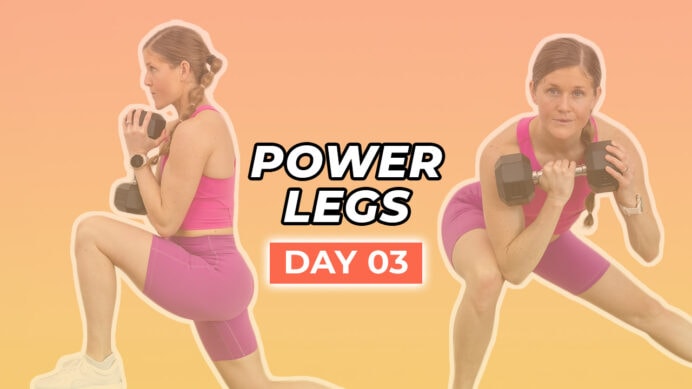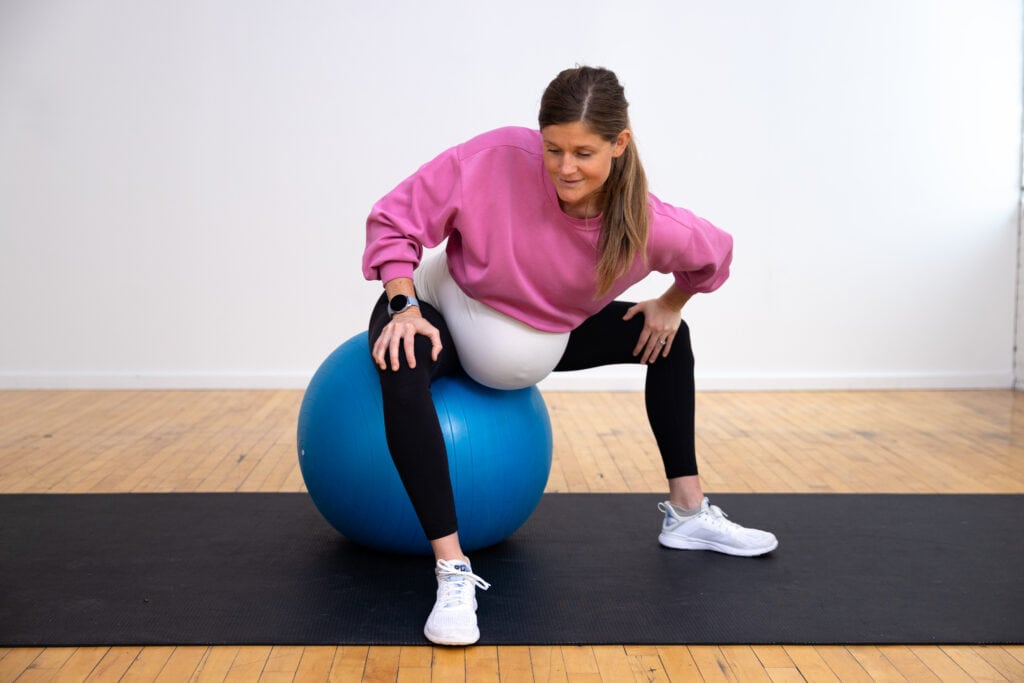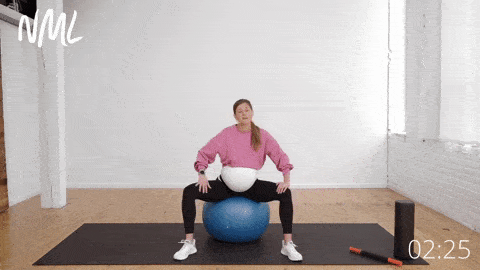 Buy Now →
Buy Now → 

Pelvic girdle pain (PGP), symphysis pubis dysfunction (SPD) pain, “lightning crotch” — whatever you call it, pelvic pain during pregnancy is frustrating. Here you’ll find 3 of the best exercises for relieving pelvic pain – designed to activate, stretch AND strip the adductor muscles. You can do these daily for pain relief.
We recently shared two pregnancy workouts focused on relieving sciatic nerve pain and low back pain during pregnancy, and my inbox was flooded with requests for another common pregnancy ailment: pelvic pain.
Stretching ligaments, changing hormone levels, shifting organs to make room for a growing uterus – these are all factors that contribute to abdominal and pelvic instability during pregnancy.
In response to that instability, the adductor muscles (or the muscles along your inner thighs that work to pull your legs in towards your body’s midline) can become overworked and tight. These adductors are directly attached to the bony portion of the pelvis that makes up the pubic symphysis attachment.
Today’s exercises serve three purposes:
This combination strengthens the adductors before lengthening them, pulling them away from the pubic symphysis disc to take some of that pressure off the pubic symphysis.

During pregnancy, the body produces the hormone relaxin which causes ligaments around your pelvis to loosen. This allows your pelvis to widen during delivery, but can cause pelvic pain during pregnancy, known as Symphysis Pubis Dysfunction (SPD).
Symphysis pubis dysfunction describes the pain and discomfort that occurs when the joint connecting the left and right pelvic bones (pubic symphysis) allows for more movement than usual.
SPD pain is felt over the pubic bone at the front in the center, roughly level with your hips. This pain is sometimes accompanied by a grinding or clicking sensation in the pubic area or lower back pain. Pain often worsens when legs are separated (going up stairs, walking, getting out of bed).
In addition to adding the exercises in today’s video to your routine, think of keeping both feet together as often as possible (“move like a mermaid”). Avoid single leg exercises and stair steppers and stick to bilateral movements with both feet on the ground like squats and deadlifts (or check out our SPD Safe Leg Day Workout). You can also try sleeping with a pregnancy pillow between not only your knees but also your ankles. Strengthening the hip muscles and pelvic floor muscles can provide more stability as well.

Relieve groin and pelvic pain during pregnancy with this quick and effective strengthening and stretching session.
Strengthen, lengthen and strip the adductor muscles that become tight and overworked during pregnancy, pulling on the symphysis and causing SPD and pelvic pain.
Add this routine to your pregnancy workout routine daily during the first trimester, second trimester and third trimester to reduce common pregnancy aches and pain in the pelvic area.
Exercise Ball and Massage Stick/Rolling Pin or Foam Roller.
If you don’t have an exercise ball, you can always perform these exercises seated on a couch or chair as well.

Follow along with the guided Exercises for Pelvic Pain During Pregnancy on YouTube, led by certified personal trainer and prenatal fitness instructor, Lindsey Bomgren.
Your Workout Looks Like This:

Targets: Strengthens the hip adductors (adductor longus, adductor brevis, adductor magnus, gracilis, and pectineu) that pull your thighs in towards the midline of your body.

Targets: Releases and lengthens the hip adductor muscles in the inner thighs, which can become tight and overworked during pregnancy.

Targets: “Strips” or massages the adductor muscles in the inner thighs, pulling the tight adductors away from the pubic symphysis disc to take some of that pressure off the pubic symphysis.
I’m using a massage stick but you can use a rolling pin as well.

 Buy Now →
Buy Now →  Buy Now →
Buy Now → 
Perfectly Oversized Cropped Crew
Buy Now →
This post includes affiliate links. I do earn a commission for products purchased using these links (at no additional cost to you). Thank you for supporting Nourish Move Love, making the content you see on this blog possible.
do you have a link to your belly band?
Hi, Kate! My SI Belt is from Amazon! Here’s the link: https://amzn.to/3B0i0BF
-Lindsey